- Србија
Упознајте Србију
- Грађани
Образовање
Култура и наука
Здравство
- Посао
Запошљавање
Привредна клима
- Медији
- Влада
Влада Републике Србије
- Контакт
Будимо у контакту
Контакт форма
Назад
Будимоу контакту
Било да имате питање, коментар, сугестију или било какав проблем који је у оквиру надлежности Владе, пошаљите нам своју поруку и потрудићемо се да вам одговоримо у најкраћем року. Уколико ваш проблем излази из оквира наших овлашћења, проследићемо поруку надлежној институцији.
П:
О:
Читај ми
Отворене понуде за предузеће "Вршачки виногради"
Београд,
30. мај 2005.
Агенција за приватизацију Републике Србије саопштила је да је Тендерска комисија за предузеће "Вршачки виногради" а.д. из Вршца јавним отварањем понуда за куповину 70 одсто друштвеног капитала овог предузећа, на седници одржаној 25. маја, констатовала да су у предвиђеном року пристигле четири понуде.
Понуде су дали конзорцијум Vitis s.r.l. Италија, OMDP Macchine Agricole s.r.l. Италија, Atanasio Lovisa, Италија, Illario & Diego Lovisa, Италија, Mauro Lovis, Италија и Paulo Louisa, Италија, конзорцијум Helvetia, концерн "Swisslion-Таково" д.о.о, Београд и конзорцијум "Винопродукт Чока" д.о.о. Суботица, ТУП "Родић MБ&Co" д.o.o, Кула и "Шећер + Schaffer" d.o.o, Београд.
У саопштењу се наводи да су тендерску документацију откупили OMDP Macchine Agricole s.r.l. Италија, "Конзорцијум Вршац" д.о.о, Вршац, концерн "Swisslion-Таково" д.о.о, Београд, "Weltika SA", Швајцарска и "Винопродукт Чока" д.о.о, Суботица.
Тендерска комисија је на основу мишљења саветника Агенције за приватизацију да достављена квалификациона документација конзорцијума Vitis s.r.l. Италија, OMDP Macchine Agricole s.r.l. Италија, Atanasio Lovisa, Италија, Illario & Diego Lovisa, Италија, Mauro Lovis, Италија и Paulo Louisa, Италија, конзорцијума Helvetia и концерна "Swisslion-Таково" д.о.о. из Београда не задовољава квалификационе критеријуме и услове тендера, одлучила да прогласи понуде наведених понуђача неважећим.
Тендерска комисија, којом је председавао заменик министра пољопривреде, шумарства и водопривреде Данило Голубовић као представник из реда републичких органа, заседала је у саставу саветник у Министарству привреде као представник из реда републичких органа Горан Батак, генерални директор предузећа "Вршачки виногради" као представник субјекта приватизације Драган Ступар, руководилац ОЈ за експлоатацију машина предузећа као представник репрезентативног синдиката субјекта приватизације Јаблан Врекић и председник Општине Вршац као представник локалне самоуправе према седишту субјекта приватизације Јовица Заркула.
Финансијски и правни саветници Агенције за приватизацију ће у року од највише 30 дана од дана отварања понуда извршити оцену понуда конзорцијума "Винопродукт Чока" д.о.о. Суботица, ТУП "Родић МБ&Co" д.о.о, Кула и "Шећер + Schaffer" д.о.о, Београд, које су биле предмет јавног отварања, објашњава се у саопштењу и додаје да ће оцена понуде бити презентована на следећој седници Тендерске комисије за предузеће "Вршачки виногради" а.д, Вршац.
Тендерска комисија је на основу мишљења саветника Агенције за приватизацију да достављена квалификациона документација конзорцијума Vitis s.r.l. Италија, OMDP Macchine Agricole s.r.l. Италија, Atanasio Lovisa, Италија, Illario & Diego Lovisa, Италија, Mauro Lovis, Италија и Paulo Louisa, Италија, конзорцијума Helvetia и концерна "Swisslion-Таково" д.о.о. из Београда не задовољава квалификационе критеријуме и услове тендера, одлучила да прогласи понуде наведених понуђача неважећим.
Тендерска комисија, којом је председавао заменик министра пољопривреде, шумарства и водопривреде Данило Голубовић као представник из реда републичких органа, заседала је у саставу саветник у Министарству привреде као представник из реда републичких органа Горан Батак, генерални директор предузећа "Вршачки виногради" као представник субјекта приватизације Драган Ступар, руководилац ОЈ за експлоатацију машина предузећа као представник репрезентативног синдиката субјекта приватизације Јаблан Врекић и председник Општине Вршац као представник локалне самоуправе према седишту субјекта приватизације Јовица Заркула.
Финансијски и правни саветници Агенције за приватизацију ће у року од највише 30 дана од дана отварања понуда извршити оцену понуда конзорцијума "Винопродукт Чока" д.о.о. Суботица, ТУП "Родић МБ&Co" д.о.о, Кула и "Шећер + Schaffer" д.о.о, Београд, које су биле предмет јавног отварања, објашњава се у саопштењу и додаје да ће оцена понуде бити презентована на следећој седници Тендерске комисије за предузеће "Вршачки виногради" а.д, Вршац.
-
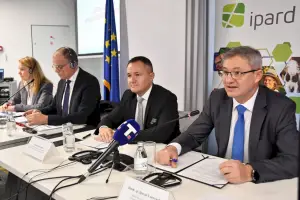 Београд, 26. новембар 2025.
Београд, 26. новембар 2025.Повећати ефикасност спровођења ИПАРД III програма
-
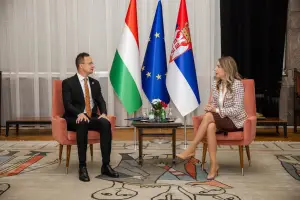 Београд, 26. новембар 2025.
Београд, 26. новембар 2025.Највиши ниво сарадње и размене информација са Мађарском у...
-
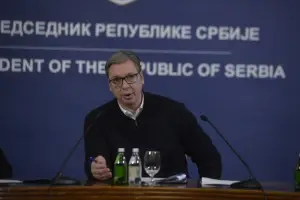 Београд, 25. новембар 2025.
Београд, 25. новембар 2025.Одлука OFAC-а о лиценци за НИС у наредна четири дана
-
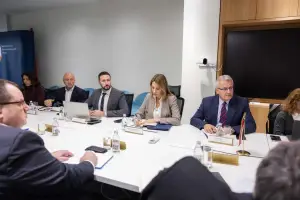 Београд, 24. новембар 2025.
Београд, 24. новембар 2025.Држава ће очувати стабилност снабдевања нафтним дериватима
-
 Београд, 24. новембар 2025.
Београд, 24. новембар 2025.Успостављен Регистар канцеларија Комесара секције
-
 Београд, 23. новембар 2025.
Београд, 23. новембар 2025.Биће довољно свих нафтних деривата на домаћем тржишту
-
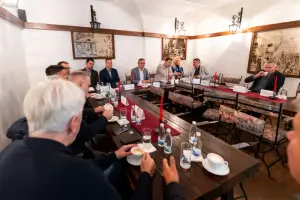 Београд, 23. новембар 2025.
Београд, 23. новембар 2025.Држава остаје потпуно посвећена развоју сектора вина и...
-
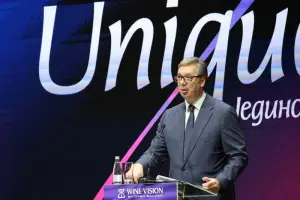 Београд, 22. новембар 2025.
Београд, 22. новембар 2025.Отворен међународни сајам Винска визија Отвореног Балкана
-
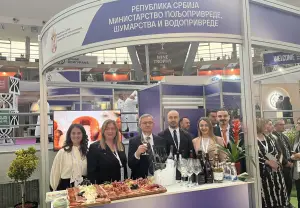 Београд, 22. новембар 2025.
Београд, 22. новембар 2025.Србија домаћин највећег регионалног гастро догађаја
-
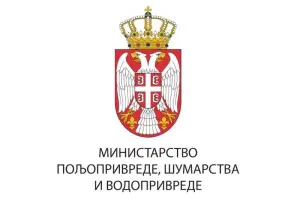 Београд, 21. новембар 2025.
Београд, 21. новембар 2025.Свеобухватне мере државе за развој винског сектора
